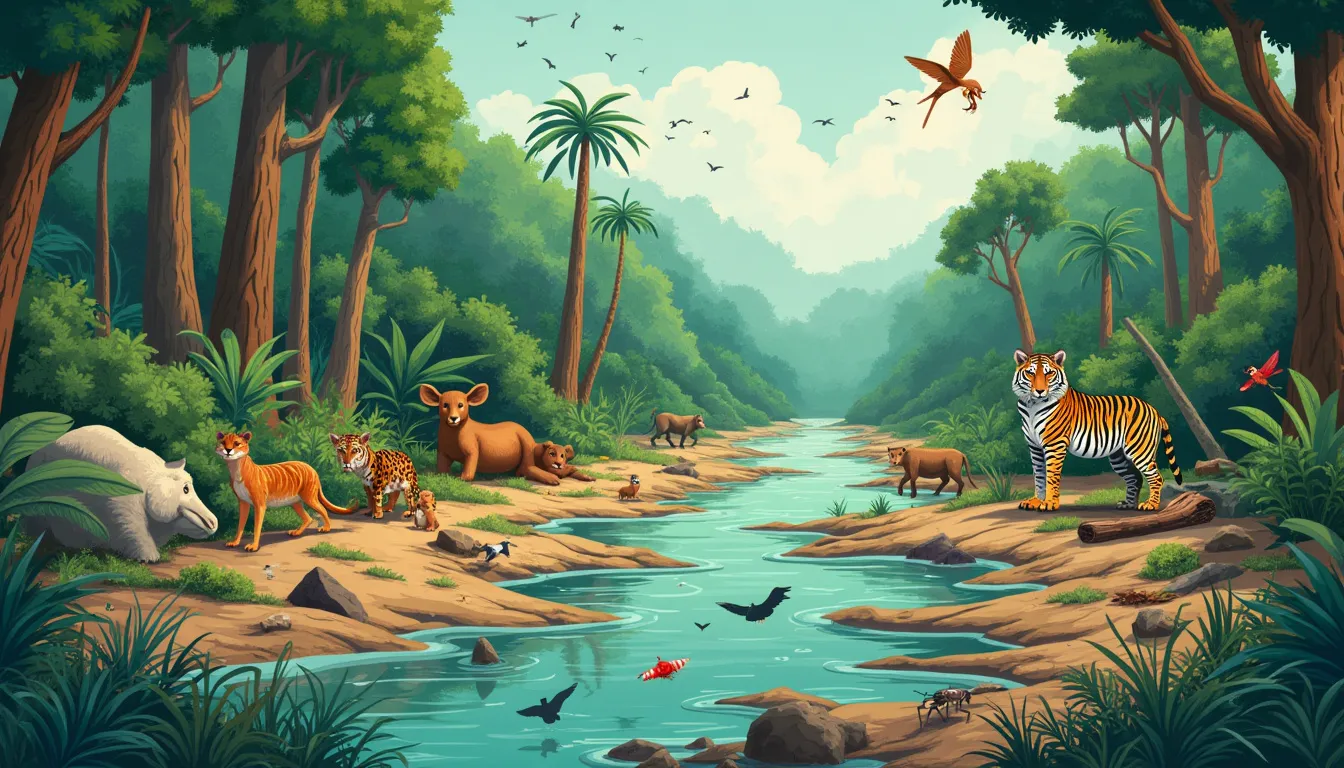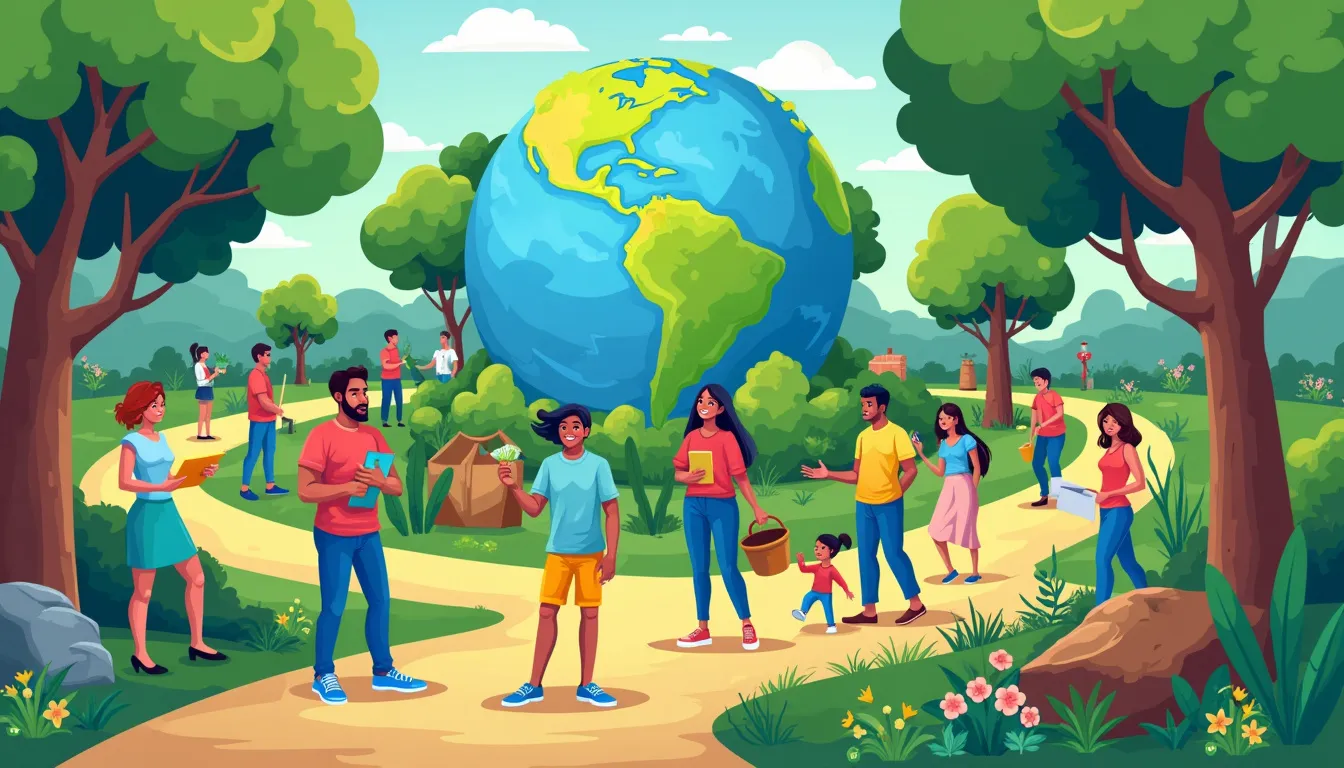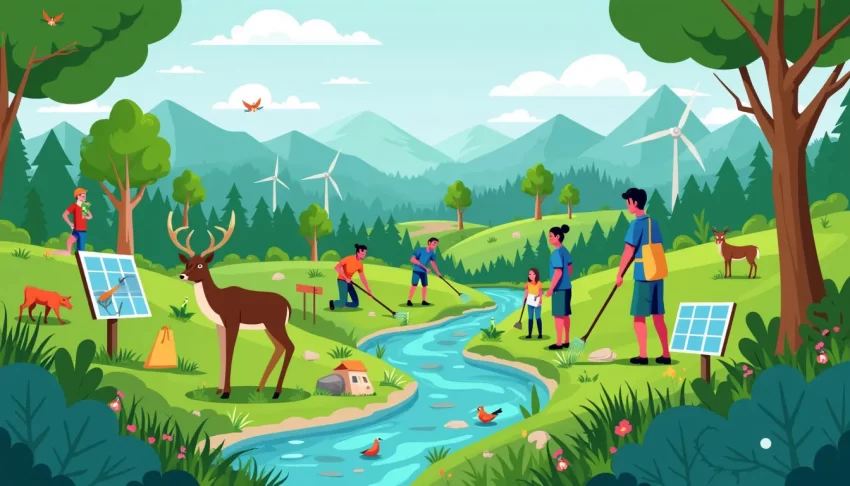Our planet is at a critical juncture. Environmental issues such as climate change, pollution, and deforestation are no longer distant threats – they are here, impacting our daily lives in profound ways. From rising global temperatures to the alarming decrease in biodiversity, the signs are clear: we must take decisive action to preserve our environment. Protecting the environment is not just about securing the natural world for future generations; it’s also about ensuring our own survival and wellbeing. Keeping the environment healthy is crucial for sustaining the delicate balance needed for life to flourish.
We all share the responsibility of safeguarding our planet, regardless of where we live or what we do. By understanding the fundamental importance of environmental preservation, we can all make a significant difference. This article will delve into the various facets of environmental degradation and offer practical solutions for both individuals and businesses. Whether you’re a homeowner looking to reduce your carbon footprint or a business owner aiming to implement sustainable practices, you’ll find actionable tips and inspiring stories to guide your journey towards a more sustainable future.
Let’s embark on this essential exploration, not just out of obligation, but with the deep realization that a healthy environment forms the bedrock of a thriving society and economy. By making conscious choices today, we can protect our planet and secure a better tomorrow for all.
Introduction to Environmental Preservation
Brief Overview of Environmental Issues
Environmental issues aren’t just buzzwords; they’re critical challenges that impact every aspect of our planet and our lives. Climate change, deforestation, pollution, and biodiversity loss are among the most pressing problems we’re facing today. For instance, global carbon dioxide levels have reached unprecedented highs, leading to more intense and frequent climate-related disasters, such as wildfires, hurricanes, and flooding. According to the Intergovernmental Panel on Climate Change (IPCC), human activities are estimated to have caused approximately 1.0°C of global warming above pre-industrial levels.
Meanwhile, deforestation continues at an alarming rate, with an estimated 18 million acres of forest lost each year—roughly the size of Panama. Pollution, whether it’s plastic waste in our oceans or toxic chemicals in the air we breathe, poses severe risks to both wildlife and human health. For example, an estimated 8 million metric tons of plastic waste enter the oceans annually, devastating marine life and ecosystems. Similarly, poor air quality is responsible for about 7 million deaths each year, according to the World Health Organization (WHO).
Importance of Protecting the Environment
The importance of protecting the environment cannot be overstated. At its core, environmental preservation ensures the sustainability of the natural resources that we depend on for our survival. Clean water, fresh air, fertile soil, and a stable climate are fundamental to our health and well-being. But beyond these basics, a thriving environment underpins the global economy, societal stability, and even our cultural and recreational activities.
Taking actionable steps to protect the environment is crucial for preserving biodiversity. Each species, no matter how small, plays a role in the intricate web of life, contributing to the ecosystem’s balance. The extinction of species can lead to the collapse of ecosystems, affecting food security and resilience to natural disasters. For instance, bees play an essential role in pollinating plants, including many crops that feed humans. A decline in bee populations threatens agriculture, which could lead to food shortages and economic instability.
Additionally, protecting the environment helps mitigate the impacts of climate change. Sustainable practices and policies aimed at reducing greenhouse gas emissions can slow the rate of global warming, thereby reducing the frequency and severity of climate-related events. This not only saves lives but also reduces economic losses. A study by the National Bureau of Economic Research found that each ton of CO2 reduced could save the global economy $417 in climate-related damages.
Businesses, too, have a lot to gain from adopting sustainable practices. Companies that prioritize environmental responsibility often see benefits such as cost savings, improved brand reputation, and increased customer loyalty. For instance, Patagonia, a global outdoor clothing brand, has built a loyal customer base by committing to sustainability and ethical sourcing. By investing in renewable energy and reducing waste, businesses can also lower their operational costs and hedge against resource shortages and regulatory pressures in the future.
Let’s not forget the human health aspect. A healthier environment leads to healthier people. Reduced pollution levels mean fewer respiratory and cardiovascular diseases. Cleaner water means fewer waterborne illnesses. By taking care of our environment, we take care of ourselves.
The importance of environmental preservation also extends into the realm of social equity. Vulnerable populations, including low-income communities and indigenous groups, are often the most affected by environmental degradation. Floods, droughts, and pollution disproportionately impact these communities, exacerbating existing inequalities. Therefore, protecting the environment is also a step towards achieving social justice.
Our involvement in environmental initiatives connects us to a broader community and fosters a sense of shared responsibility. Whether it’s participating in local clean-up drives, supporting eco-friendly businesses, or advocating for stronger environmental regulations, every action counts.
In summary, the significance of protecting the environment spans across health, biodiversity, economy, and social justice. By understanding and addressing the pressing environmental issues we face, we can ensure a sustainable and thriving planet for future generations. The next part of the article will delve deeper into the impacts of environmental degradation, emphasizing why immediate and collective action is paramount.

The Impacts of Environmental Degradation
Effects on Wildlife and Biodiversity
Environmental degradation poses a severe threat to wildlife and biodiversity. As natural habitats are destroyed or altered, countless species face the risk of extinction. Deforestation, pollution, and climate change are primary drivers disrupting ecosystems worldwide. For instance, the encroachment upon rainforests for agriculture has led to significant losses in species such as orangutans and numerous plant species that have yet to be studied.
Studies indicate that about one million animal and plant species are now threatened with extinction, many within decades. This loss of biodiversity not only diminishes the intricate web of life but also undermines the health of our environment. Animals and plants play essential roles in maintaining ecological balance, such as pollination, seed dispersal, and natural pest control, all of which contribute to the health and productivity of ecosystems that humans rely on.
Consequences for Human Health and Society
The degradation of the environment has stark consequences for human health and society. Polluted air and water sources can lead to respiratory issues, cardiovascular diseases, and waterborne illnesses. For example, industrial pollutants and vehicle emissions contribute to air quality deterioration, leading to conditions like asthma, especially in urban areas. According to the World Health Organization (WHO), ambient air pollution is responsible for about 4.2 million deaths per year.
Moreover, the loss of clean water sources, resulting from industrial runoff and inadequate waste management, exacerbates global water scarcity. This affects drinking water supplies and agriculture, heightening food insecurity.
Beyond health, environmental degradation impacts societal structures. Natural disasters such as floods, hurricanes, and droughts have become more frequent and intense due to climate change, displacing communities and straining resources. The destruction caused by these events often disproportionately affects vulnerable populations, exacerbating social inequalities and leading to economic instability within those regions.
Economic Ramifications of Ignoring Environmental Protection
Ignoring environmental protection has significant economic ramifications. Environmental degradation affects industries such as agriculture, fisheries, and tourism, leading to substantial financial losses. For example, overfishing and pollution have severely impacted global fish populations, threatening the livelihoods of millions who depend on fishing.
Agriculture, too, suffers with soil degradation, which reduces crop yields and increases the need for chemical fertilizers and pesticides, elevating costs for farmers and consumers alike. Climate change, with its changing weather patterns, introduces further unpredictability, making it challenging for farmers to maintain consistent production levels.
Additionally, the costs associated with natural disasters are staggering. According to a report by the National Centers for Environmental Information, in 2020 alone, the U.S. experienced 22 separate billion-dollar weather and climate disasters, amounting to a total of approximately $95 billion in damages. These economic impacts extend beyond immediate damages, influencing insurance costs, disaster response, and long-term recovery efforts.
Furthermore, poor environmental practices can tarnish a company’s reputation, leading to loss of customer trust and loyalty. In contrast, businesses that prioritize sustainable practices often see enhanced brand value and customer engagement, proving that protecting the environment is not only a moral obligation but also a smart economic strategy.
To sum up, the impacts of environmental degradation reach far and wide, affecting wildlife, human health, societal structures, and the global economy. By understanding these consequences, we can better appreciate the urgency of adopting sustainable practices and investing in environmental protection. Whether through individual actions or broader policy changes, addressing these issues head-on is crucial for the prosperity of our planet and future generations.

3. Key Strategies for Protecting the Environment
Sustainable Practices: Reduce, Reuse, Recycle
Incorporating sustainable practices into our daily routines can have a significant impact on the environment. The mantra Reduce, Reuse, Recycle is a simple yet powerful strategy. By reducing waste, reusing items, and recycling materials, individuals and businesses can minimize their environmental footprint.
First, let’s talk about reduction. Reducing waste means making mindful choices about purchasing and consumption. Opt for products with minimal packaging, and avoid single-use plastics whenever possible. For businesses, this could mean rethinking packaging strategies and investing in bulk purchasing to minimize waste.
Reusing items is another critical component. Before discarding something, consider if it can be repurposed. For instance, glass jars can be used for storage, and old clothing can be transformed into cleaning rags. Some companies are even adopting take-back programs, where customers can return used products for recycling or refurbishment.
Recycling is equally important. By recycling paper, glass, metal, and certain plastics, we can significantly reduce the amount of waste that ends up in landfills. Businesses can partner with recycling programs to ensure that materials are properly processed and repurposed. The success of recycling relies heavily on proper sorting and community participation.
Renewable Energy Sources and Their Benefits
Another key strategy is adopting renewable energy sources. Renewable energy, such as solar, wind, and hydroelectric power, offers significant environmental benefits compared to fossil fuels. By investing in these clean energy options, we not only reduce greenhouse gas emissions but also decrease our dependency on finite resources.
Solar energy, for example, harnesses the power of the sun to generate electricity. Homes and businesses can install solar panels to produce their own energy, often leading to lower utility bills and a smaller carbon footprint. In many regions, governments offer incentives for installing solar panels, making it a more accessible option.
Wind power is another promising source of renewable energy. Wind turbines convert wind energy into electrical power, providing a constant energy supply without emitting greenhouse gases. Offshore wind farms, in particular, are gaining popularity due to their efficiency and reduced visual impact on landscapes.
Hydroelectric power, generated by harnessing water flow, is one of the oldest and most reliable renewable energy sources. Dams and other hydroelectric plants can produce large amounts of electricity while simultaneously providing water management benefits, like flood control and irrigation support.
Switching to renewable energy not only helps protect the environment but also stimulates economic growth by creating jobs in the green energy sector. For businesses, investing in renewable energy can enhance their corporate sustainability profile and attract eco-conscious customers.
Legislations and Policies for Environmental Protection
Government legislation and policies play a crucial role in environmental protection. Effective regulatory frameworks can enforce sustainable practices, reduce pollution, and preserve natural resources.
One notable example is the establishment of emission standards for vehicles and industrial facilities. These regulations aim to limit the release of harmful pollutants into the air, thereby improving air quality and public health. The Clean Air Act in the United States is a prime example of such legislation, significantly reducing emissions since its inception.
International agreements also play a pivotal role. The Paris Agreement, for instance, unites countries in the global effort to combat climate change by limiting global warming to below 2 degrees Celsius. Participants commit to reducing greenhouse gas emissions and investing in green technologies.
Renewable portfolio standards (RPS) are another effective tool. These policies require utilities to source a specific percentage of their energy from renewable sources. By setting clear targets, RPS policies drive investments in renewable energy infrastructure and innovation.
Businesses can also benefit from environmental legislations through various incentives and subsidies. Tax credits for renewable energy installations, grants for research and development, and subsidies for energy-efficient equipment are just a few examples. These incentives not only make it easier for businesses to adopt sustainable practices but also enhance their competitiveness and reputation.
Moreover, local policies like urban green spaces, recycling mandates, and water conservation regulations contribute significantly to environmental protection at the community level. By supporting and complying with these regulations, both individuals and businesses can actively participate in preserving our planet.
In summary of this section, adopting sustainable practices, investing in renewable energy, and supporting environmental legislations are key strategies for protecting the environment. By making informed choices and participating in these efforts, individuals and businesses can contribute significantly to a healthier, more sustainable planet.

Collective Efforts and Individual Actions
Environmental preservation is not a responsibility that falls solely on governments or large organizations; it’s a collective effort that thrives on the contribution of every community and individual. Understanding this, we can begin to explore the multitude of ways we can each play a role in protecting our environment. Let’s delve into how community initiatives and grassroots movements, combined with individual actions and heightened education and awareness, can generate significant positive impacts.
Community Initiatives and Grassroots Movements
Communities around the world are becoming hotbeds for environmental innovation and action. Local initiatives, often spearheaded by passionate individuals or small groups, can have surprisingly far-reaching impacts. Take, for example, the Transition Towns movement. This grassroots initiative began in the UK and has now spread to over 50 countries. Transition Towns bring local people together to create plans aimed at building community resilience in the face of environmental challenges, with efforts focused on sustainable living, reducing carbon emissions, and fostering local economies.
Another compelling example is citizen-led tree-planting campaigns. Kenya’s Green Belt Movement, founded by Nobel laureate Wangari Maathai, has not only contributed to the planting of over 51 million trees but has also galvanized numerous community-based climate adaptation activities. Such projects do more than just plant trees; they educate and engage communities, often women-led groups, empowering them to take a leading role in environmental stewardship.
Now consider the impact of urban farming initiatives, which transform vacant urban spaces into community gardens. These projects address multiple environmental issues, from reducing food miles to enhancing urban biodiversity and educating local residents about sustainable agriculture. Examples like Growing Power in Milwaukee have shown how urban farms can flourish, providing fresh produce and fostering a sense of community.
How Individuals Can Contribute to Environmental Preservation
While community initiatives are impactful, individual actions are equally crucial in the collective effort to safeguard our environment. Here are practical steps that each of us can take to make a difference:
- Adopt the Three Rs: Reducing our consumption, reusing items where possible, and recycling waste can significantly minimize our environmental footprint. For instance, using reusable shopping bags, water bottles, and coffee cups can be small steps with big impacts.
- Support Sustainable Products: Choosing products that are sustainably sourced, made from recycled materials, or organically produced supports companies that prioritize environmental responsibility. Look for certifications like Fair Trade, Rainforest Alliance, or the FSC label on wood products.
- Utilize Renewable Energy: Where possible, switch to renewable energy sources for your home or business. Many energy providers now offer green energy tariffs that ensure your electricity comes from renewable sources like wind, solar, or hydroelectric power.
- Reduce Energy Consumption: Simple actions like turning off lights when not in use, using energy-efficient appliances, and insulating your home can decrease your energy consumption, lower your bills, and reduce your carbon footprint.
- Advocate for Change: Use your voice to advocate for environmental policies and practices within your community or workplace. Join environmental groups, participate in local clean-up events, or even write to your representatives to express your support for environmental legislation.
The Role of Education and Awareness in Environmental Conservation
Education and awareness are indispensable tools for driving environmental conservation. By understanding the issues and solutions, people are more likely to engage in behaviors that positively impact the environment. Environmental education starts with instilling awareness from a young age. Schools that incorporate environmental science into their curriculums not only educate children about the environment but also inspire them to be stewards of the planet. The EcoEducation program by The Nature Conservancy is a prime example; it provides hands-on learning experiences that connect students directly to nature.
For adults, lifelong learning and continued engagement in environmental issues are pivotal. Local workshops, community talks, and accessible online resources can offer valuable insights into sustainable living practices. Moreover, the influence of media cannot be overstated. Documentaries like Our Planet narrated by Sir David Attenborough, have successfully raised global awareness about critical environmental issues, motivating viewers to act.
Ultimately, education paves the way for informed decisions and proactive measures. Consider the example of energy consumption. A well-informed individual who understands the environmental impact of excessive energy use is more likely to invest in energy-efficient appliances, use LED lighting, or reduce heating costs by better insulating their home. Knowledge empowers action.
In summary, collective efforts through community initiatives and individual actions, fueled by education and awareness, are fundamental to the momentum needed for environmental conservation. When people understand the importance of protecting the environment and are equipped with the knowledge and resources to make a difference, they can instigate profound, lasting change. Our planet’s future depends on the collaborative efforts of us all.
In conclusion, the urgency of protecting our environment cannot be overstated. As we face escalating environmental issues, from loss of biodiversity to severe health consequences, it becomes increasingly clear that our actions today directly shape the world of tomorrow. Environmental degradation affects not just wildlife, but also the health, economies, and overall well-being of human societies across the globe.
Fortunately, there are robust strategies and practical steps we can all take to preserve our planet. By embracing sustainable practices such as reducing waste, reusing materials, and recycling, we can significantly lower our environmental footprint. Additionally, investing in and advocating for renewable energy sources, like solar and wind power, not only helps reduce greenhouse gas emissions but also promotes energy independence and economic growth.
Legislations and policies play a crucial role in shaping a sustainable future. Supporting and complying with environmental laws ensures that industries operate within safe and ecological limits, protecting natural resources and biodiversity for generations to come. But institutional efforts alone are not enough.
Collectively, community initiatives and grassroots movements amplify the call for environmental preservation. Local projects and global campaigns alike inspire action and foster a shared sense of responsibility. As individuals, our contributions, no matter how small, add up. Simple, everyday choices like conserving water, reducing plastic use, and supporting eco-friendly products make a significant difference.
Furthermore, education and awareness are the bedrock of any enduring change in environmental conservation. By spreading knowledge and fostering a culture that values the environment, we empower ourselves and future generations to make informed decisions that favor sustainability.
The journey to a cleaner, healthier planet requires concerted effort and unwavering commitment. It demands that we rethink our habits, support sustainable innovations, and engage in active stewardship of our environment. While the challenges are substantial, the rewards of safeguarding our earth—a thriving, vibrant planet—are immeasurable. Let us take the first steps today to ensure a better tomorrow for all living beings.
Support Us: Check out our recommended products on Amazon.

